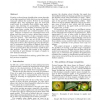Free Online Productivity Tools
i2Speak
i2Symbol
i2OCR
iTex2Img
iWeb2Print
iWeb2Shot
i2Type
iPdf2Split
iPdf2Merge
i2Bopomofo
i2Arabic
i2Style
i2Image
i2PDF
iLatex2Rtf
Sci2ools
ACSW
2004
2004
A wavelet-based neuro-fuzzy system for data mining small image sets
Creating a robust image classification system depends on having enough data with which one can adequately train and validate the model. If there is not enough available data, this assumption may not hold and would result in a classifier that exhibits poor performance, thus lowering it's acceptability. This paper offers a solution to the problem of training and testing a neuro-fuzzy system for the purpose of image recognition when there are a limited number of images. Features of interest are segmented from each image and then used to train a neural-fuzzy system. This increases the number of data examples used to train the system. The neuro-fuzzy system is then tested on the entire data set set of full images. A high level of classification accuracy has been obtained using this method. This solution has two advantages; one, it overcomes the problem of limited data examples for training a classification model and two, rules can be extracted from the neuro-fuzzy model for further an...
| Added | 30 Oct 2010 |
| Updated | 30 Oct 2010 |
| Type | Conference |
| Year | 2004 |
| Where | ACSW |
| Authors | Brendon J. Woodford, Da Deng, George L. Benwell |
Comments (0)

